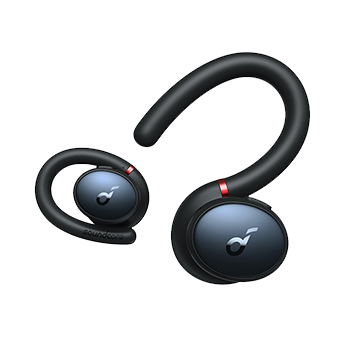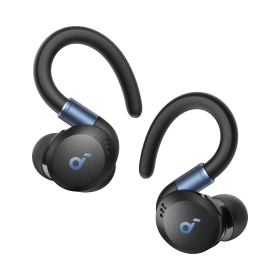Air Conduction vs. Bone Conduction: Sound Transmission Explored
In the world of auditory experiences, the technology behind how we perceive sound is as diverse as it is innovative. Two prominent players in this space, air conduction, and bone conduction, have carved distinct niches, each offering unique advantages and experiences to the user. As listeners become more discerning and the quest for the optimal balance between sound quality, comfort, and situational awareness intensifies, understanding the nuances of these two technologies becomes paramount. In this exploration, we’ll delve into the essence of these two technologies, compare the merits of open-ear air-conduction vs. bone-conduction headphones, and introduce the pioneering soundcore Aerofit series that exemplifies the innovation in air-conduction technology.
What Is Air Conduction?
Air conduction is the traditional method of sound transmission, where sound waves travel through the air and are captured by our ears. When these waves enter the ear canal, they cause the eardrum to vibrate. These vibrations then journey through the middle ear bones to the cochlea in the inner ear. Here, they are transformed into electrical signals and relayed to the brain, allowing us to perceive sound. This natural mechanism is the foundation of most audio devices, including headphones.
What are air conduction headphones? There are two primary types of air-conduction headphones:
- Traditional Open-Back Headphones: These headphones have ear cups with an open design on the back, allowing sound to escape. They provide a natural sound-stage but do not use bone conduction, making them suitable for audiophiles.
- Semi-Open Headphones: Semi-open headphones feature partially open-ear cups, offering a balance between sound leakage and isolation. They find use in various audio applications, including studio recording.

What Is Bone Conduction?
Bone conduction is an alternative method of sound transmission that bypasses the ear canal and eardrum. What are bone conduction headphones and how do bone conduction headphones work? Instead of sound traveling through the air and entering the ear canal, bone conduction headphones transmit sound as vibrations directly to the bones of the skull. These vibrations are then conducted through the bone to the inner ear, where they are perceived as sound.
There are two primary types of bone conduction:
- Direct Bone Conduction: In direct bone conduction, a transducer or speaker is placed against the skin on the cheekbones or temples. When the speaker produces sound, it creates vibrations that are directly transmitted to the bones. This technology is commonly used in bone conduction headphones, allowing users to listen to audio while keeping their ear canals open to external sounds.
- Implanted Bone Conduction: In this type, a bone-anchored hearing aid (BAHA) or a similar device is surgically implanted into the skull bone, typically behind the ear. The implanted device transmits vibrations to the skull bone, which then reach the inner ear. It is used as a medical solution for certain types of hearing loss.
Air Conduction vs. Bone Conduction Headphones: Which Is Better?
Having gained insights into both air conduction and bone conduction, a pressing question resonates among audiophiles and everyday listeners: Is air conduction greater than bone conduction?
This question opens the doors to a rich debate surrounding bone conduction vs. air conduction open-ear headphones. Each technology offers a unique auditory experience, and choosing between them can be influenced by air and bone conduction headphones pros and cons, including sound quality, comfort, and situational awareness. Let’s delve deeper into the comparative analysis of these two innovative headphone types.
Sound Quality
When it comes to sound quality, the narrative often leans towards air conduction greater than bone conduction.
Open-ear air-conduction headphones tend to deliver a richer and more refined auditory experience. They utilize the natural acoustics of the ear, offering a broader range of frequencies and clearer audio output.
On the contrary, bone-conduction headphones, while offering a unique and innovative listening experience, might not reproduce the subtle nuances in music as effectively as air-conduction headphones. The sound quality can sometimes be perceived as thinner or lacking in bass.
Comfort and Fit
Bone-conduction headphones are known for their lightweight and comfortable wear, especially for extended periods. They rest on the cheekbones and leave the ear canals open, making them a preferred choice for those who find in-ear or over-ear headphones uncomfortable or intrusive.
Open-ear air-conduction headphones, on the other hand, offer the comfort of familiar audio delivery. They don’t press into but hover above the ear canals, reducing the pressure and heat build-up associated with traditional headphones. This design is particularly appealing to those who might find the vibrations of bone-conduction headphones a tad unsettling.
Safety and Awareness
The bone conduction greater than air conduction argument finds its stronghold in scenarios where awareness of surroundings is crucial.
Bone-conduction headphones sit on the cheekbones, leaving the ears open entirely. The design ensures that ambient sounds are not blocked, a significant safety feature for runners, cyclists, and pedestrians in busy environments.
Open-ear air-conduction headphones also support situational awareness to an extent but might not offer the same level of environmental sound permeability as bone-conduction headphones.
When choosing between bone-conduction vs. air-conduction headphones, understanding your specific needs, preferences, and the environments in which you’ll be using the headphones most frequently can guide you to a choice that harmonizes with your lifestyle.
Bonus: soundcore Open-Ear Headphones for Your Choice
At soundcore, we believe in transcending the ordinary, engineering audio experiences that defy boundaries. The Aerofit series is a testament to our commitment to excellence and innovation. Every beat, every note, and every rhythm is a journey, and with our stellar open-ear air-conduction models - the Aerofit and Aerofit Pro, you’re stepping into a world where every listening experience is a narrative of passion and precision.
soundcore Aerofit Pro
Elevate your listening experience with our flagship open-ear headphones, the soundcore Aerofit Pro. Crafted for the discerning audiophile and the active individual, the Aerofit Pro seamlessly marries ergonomic excellence with unparalleled audio fidelity. The soft silicone cushion ensures a snug fit, even during the most vigorous activities, allowing you to immerse yourself in our signature sound without missing a beat of your surroundings. With its extended battery life, rapid charging case, and robust resistance to both dust and water, the Aerofit Pro isn't just a headphone; it's a resilient companion ready to face the elements with you.

soundcore Aerofit
Meet the soundcore Aerofit – your everyday companion that combines affordability, comfort, and quality in a compact design. Walk, talk, relax, and explore with the confidence of having a headphone that fits seamlessly into every aspect of your life. With user-friendly features like the quick-charge case and intuitive controls, the Aerofit ensures that premium audio is always within reach. Dive into a world where quality meets value only with soundcore.
FAQ
Can other people hear your music with air or bone conduction headphones?
Yes, both air-conduction and bone-conduction headphones can exhibit some degree of sound leakage, especially at higher volumes. This means others nearby might be able to hear your music. The extent of leakage can vary depending on the headphone design and surrounding environment.
Can I sleep with open-ear or bone conduction headphones?
Yes, both open-ear and bone-conduction headphones are designed to reduce pressure against the ears and allow ambient noise, making them a comfortable and safe option for sleeping while still being able to hear important sounds like emergency alerts. However, comfort may vary based on your sleeping position and the specific headphone model.
Conclusion
As we draw the curtains on this enlightening discourse, it becomes evident that the choice between air conduction vs. bone conduction is as personal as it is complex. Each technology, with its unique attributes, caters to diverse needs, environments, and preferences. In the end, whether you’re swayed by the natural and immersive soundscape offered by air conduction or the ambient awareness and unique listening experience of bone conduction, there is a world of sound waiting to be explored, experienced, and cherished.





























































